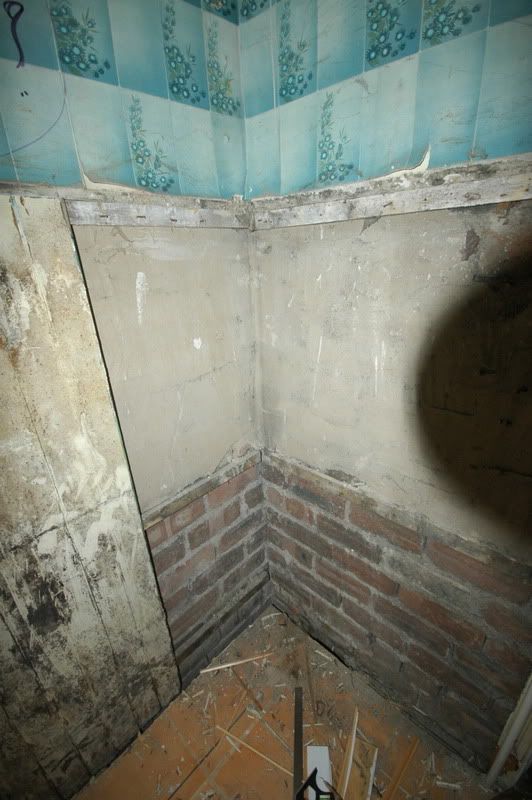Basically as a follow on from my question about skimming tongue & groove ceilings... the whole bathroom was clad in tongue and groove. I have begun to strip it all away as part of a total bathroom refurb. Under the newer T&G were a few things.
From the floor to about 150cm up the wall was possibly original wooden t&g cladding (this is a 107 year old building) under which were two finishes.
From the floor up to just about 100cm is bare brick.
From there up to where the old wood cladding terminated is some kind of rough render, dark grey and sandy/chalky when removed though quite hard and of varying thickness from verythin to about 15-20mm in places.
Above where the old wood cladding was is a smooth flat render (under the horrible old blue wallpaper in the first pic) which is hard to touch, slightly rough and white in colour, this seems to have been applied over another darker greyish render, possibly the same as the aforementioned stuff. This finish goes to the ceiling. Both renders seem to have very fine fibres/hairs through them.
Basically because this is a smallish room I would ideally like to remove this render back to brick as it will win me back just enough space to install a 900mm quadrant shower rather than an 800mm.
Any ideas what this render is? I'm presuming just old plaster but either way would it be a reasonable proposition to remove this back to the brickwork?
If I do so would the best tool for the job be an SDS drill with wide chisel bit?
I was thinking on getting back to brick, at least on the two walls touched by the shower, then dot & dabbing 12.5mm drywall on, with 12.5mm in the 900mm sections of the walls covered by the shower enclosure, the area I talk about is in the first pic.
Any thoughts on how to deal with this and then refinish the walls would be appreciated!


From the floor to about 150cm up the wall was possibly original wooden t&g cladding (this is a 107 year old building) under which were two finishes.
From the floor up to just about 100cm is bare brick.
From there up to where the old wood cladding terminated is some kind of rough render, dark grey and sandy/chalky when removed though quite hard and of varying thickness from verythin to about 15-20mm in places.
Above where the old wood cladding was is a smooth flat render (under the horrible old blue wallpaper in the first pic) which is hard to touch, slightly rough and white in colour, this seems to have been applied over another darker greyish render, possibly the same as the aforementioned stuff. This finish goes to the ceiling. Both renders seem to have very fine fibres/hairs through them.
Basically because this is a smallish room I would ideally like to remove this render back to brick as it will win me back just enough space to install a 900mm quadrant shower rather than an 800mm.
Any ideas what this render is? I'm presuming just old plaster but either way would it be a reasonable proposition to remove this back to the brickwork?
If I do so would the best tool for the job be an SDS drill with wide chisel bit?
I was thinking on getting back to brick, at least on the two walls touched by the shower, then dot & dabbing 12.5mm drywall on, with 12.5mm in the 900mm sections of the walls covered by the shower enclosure, the area I talk about is in the first pic.
Any thoughts on how to deal with this and then refinish the walls would be appreciated!




